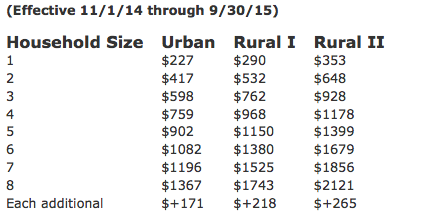Last Updated on January 16, 2024 by Lori Pace
Alaska has many public assistance programs for single mothers to take advantage of each year. The state understands the difficulties of life and wants to help everyone thrive.
According to the statistics, 24,647,000 children lived in single-parent homes in 2013. This number has remained about the same for the past few years, as shown in the image below.

Data provided by National KIDS COUNT
The poverty rate of children living in single-parent families is very high. Almost 40 percent of children living in single-parent families live in poverty across the country. Nearly 4.6 million in 2012 of parents who have never married lived in poverty.
The need for assistance is obvious, which is why Alaska has programs in place to help. Most of them only need an application upon meeting specific requirements.
Alaska Medicaid
Medicaid is a federally funded healthcare insurance program that helps children, adults with disabilities, and older adults seek quality medical care. Medicaid works just like insurance, with some limitations on what it covers.
Eligibility requirements
Medicaid recipients must be children under the age of 18, adults are over the age of 65, have a proven disability as an adult, or be pregnant. All recipients must meet the Federal Poverty Level (FPL).
Funding Amount
Medicaid recipients receive free medical care from approved healthcare professionals.
Website and contact detail
To learn more about Alaska Medicaid, visit the Department of Health and Social Services website. You can also call 907-465-3347.
Alaska food stamps
Public Assistance: Alaska Food Stamp Program
The Alaska Food Stamp Program offers food cards to people with a low income. You can only use these food cards for some items – usually foods that promote recipients’ health and well-being.
Eligibility requirements
You need to meet 130% of the Alaska poverty standard at the application time, which is $2,250 for most households. People with a disability or 60 years or older have a $3,250 limit.
Funding Amount
Funding depends on income and poverty level at the time of application. The following chart shows the average food stamp benefit:

Website and contact details
For more information about the food stamps program in Alaska, go to the Department of Health and Social Services website.
Alaska Special Program for Women, Infants, & Children
Women, Infants, and Children (WIC) assist children and pregnant women. Assistance supports the nutrition and healthcare needs of low-income children and women.
Eligibility requirements
Help is income-based: Children and women are eligible for WIC if they meet the guidelines for food stamps, Medicaid, Denali Kid Care, and Alaska Temporary Assistance Program.
In general, the eligibility requirements are:
- Pregnant.
- Breastfeeding.
- If you recently had a baby.
- Have a child under the age of five, meet income eligibility, and have a nutritional need.
Funding Amount
Funding depends on needs, and mothers and children receive care, food, and education. The program assesses the children’s needs and mothers to determine how much is needed.
Website and contact details
For more information about WIC in Alaska, visit that section of the website.
Unemployment Alaska
Alaska Unemployment Insurance
Unemployment insurance offers compensation to those who lose their job. It helps to cover expenses until the recipient finds a new job.
Eligibility requirements
Eligibility requirements include having earned wages from employment, have a total gross income of $2,500, and be available for full-time work.
Funding Amount
Alaska offers a minimum weekly benefit of $56, and the maximum is $370 per week. Compensation is only provided for a certain amount of time determined during the application process.
Website and contact detail
To apply for unemployment insurance, consult the Department of Labor website. To find your local office, visit this site.
Child Support Alaska
Alaska Temporary Assistance Program (ATAP)
This program provides cash to needy families with children; you can use the money to support necessities such as food, clothing, and shelter.
Eligibility requirements
Families must have less than $2,000 countable resources. Families with an individual who is 60 years or older have a limit of $3,000. These resources do not include a home, personal goods, and vehicles.
Funding Amount
The amount a family receives depends on the family’s size, income, and how much is paid towards shelter.

Website and contact details
For more information about applying for ATAP, visit the Alaska ATAP website.
Alaska Denali Kidcare (CHIP)
Denali Kidcare provides health insurance to a needy family with children and teens to ensure they receive the medical care they need.
Eligibility requirements
Working and non-working families with children under 18 are eligible for help. Pregnant women may also be suitable, but they will consider income guidelines.
Funding Amount
This program offers health insurance to cover medical expenses from routine healthcare appointments.
Website and contact details
For more information about Alaska Denali Kidcare (CHIP), visit the Department of Health and Social Services website. There is an application form on the website.
Alaska Child Care Public Assistance Program “Parents Achieving Self Sufficiency (PASS)
PASS provides child care assistance for eligible families, and the parents must be getting an education or in training.
PASS I.
Provides child care assistance to those who are receiving benefits from ATAP
PASS II.
This is for families transitioning from ATAP.
PASS III.
Program for families who may not be eligible for PASS I or PASS II.
Eligibility requirements
Each part of the program has its eligibility requirements. PASS I and PASS II recipients must be receiving benefits from ATAP and be working. PASS II recipients must be working, attending school, or in a job training program. Eligibility is also based on the family’s income and size.
Funding Amount
The number of child care hours is determined by your work or job training hours. Child care expenses are paid for directly to the provider.
Website and contact details
For more information about the PASS programs, visit the Alaska Division of Public Assistance.
Alaska General Relief Assistance
The General Relief Assistance (GRA) provides financial help to families in an emergency. It’s usually the last resort for families. If the family cannot receive any other assistance, they will grant GRA.
Eligibility requirements
The household must be getting assistance from any other state program. The recipient must be an adult, married, or living apart from their parents. Household resources must not exceed $500 and meet income limits, depending on household size.
Funding Amount
Funding depends on family size, need, and income. Limits are $300 for one person, $400 for two people, and $500 for three people.
Website and contact details
Visit the Department of Health and Social Services of Alaska for more information about GRA.
Scholarships in Alaska
Gear Up Alaska Scholarship
GEAR UP stands for Gaining Early Awareness and Readiness for Undergraduate Programs. It is a discretionary grant program to help low-income students seek a postsecondary education.
Eligibility requirements
This program is for state agencies seeking to provide education to low-income students. Education agencies that are part of Institutions of Higher Education (IHEs), Local Education Agencies (LEAs), and State Education (SEAs) may be eligible.
Funding Amount
Grants may be up to $5,000 per year. They are limited to $800 per student.
Website and contact details
For more eligibility information and to apply, visit this website.
Alaska Grants
Alaskadvantge Education Grant
The Alaska Education Grant (AEG) program helps students seeking an education at a postsecondary educational institution in Alaska.
Eligibility requirements
Requirements include:
- Alaska resident
- U.S. citizen or permanent resident
- High school diploma or GED
- In an undergraduate degree program or vocational certificate program
- Enrolled in the program at least half-time
- Financial need of $500 or more
- You do not have a baccalaureate degree.
- Meet academic progress requirements satisfactory
Funding Amount
Awards are $500 to $4,000 for each academic year.
Website and contact details
For more information about Alaskadvantage Education Grant, visit the program’s website.
Homeschooling in Alaska
Homeschooling Laws
Children can be taught at home by a parent or guardian. There is no requirement to notify or get approval to teach children in the house. Parents and legal guardians do not need teaching qualifications.
Eligibility requirements
Children who attend public school for the first grade or at six years old must attend. The children will then need to remain in public schools between 7 and 16.
Parents do have the option of removing the child 60 days from enrollment in the first grade. Once he/she turned seven, he/she must attend school because of the attendance law.
Different available programs
For more information about homeschooling laws, contact the homeschooling website for Alaska.
Other Alaska Public Assistance Programs
Alaska Heating Assistance Program (HAP)
HAP helps households that do not have enough income to afford heating costs. It pays a portion of the expenses. The program runs each year from October 1 to April 30. Those interested must apply each year, and they send the checks in November.
Eligibility requirements
Recipients must show they can’t pay for heating expenses at the application time.
Funding Amount
The amount HAP will pay for heating costs depends on income, household size, and heating bill.
Website and contact details
For more information about HAP and apply for the program, call 1-888-804-6330 or visit the website.
Alaska Permanent Dividend (PFD)
PFD gives public assistance to Alaska residents planning to live in the state indefinitely. This program serves to keep the population up to foster profitable economic growth.
Eligibility requirements
Recipients must be Alaska residents for one full calendar year and not claim any other state as a residence. You cannot be imprisoned or sentenced for a crime the previous or current year. You can’t leave Alaska for more than 180 days and must be present for at least 72 hours.
Funding Amount
The lowest payout was in 1984, with $331.29. The amount has risen over the years, with 2008 being the highest payout of $2,069. The following chart shows the yearly payout to each eligible Alaska resident.
Website and contact details
For more information about PFD, visit the PFD website.

